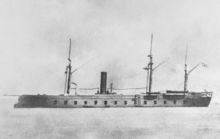Kaiser Max-class ironclad (1862)
 Photo of Prinz Eugen before 1867
| |
| Class overview | |
|---|---|
| Operators | |
| Preceded by | Drache class |
| Succeeded by | Erzherzog Ferdinand Max class |
| Built | 1861–1863 |
| In commission | 1863–1873 |
| Completed | 3 |
| Scrapped | 3 |
| General characteristics | |
| Type | Ironclad warship |
| Displacement | 3,588 long tons (3,646 t) |
| Length | 70.78 m (232 ft 3 in) pp |
| Beam | 10 m (32 ft 10 in) |
| Draft | 6.32 m (20 ft 9 in) |
| Installed power | 1,926 indicated horsepower (1,436 kW) |
| Propulsion |
|
| Speed | 11.4 knots (21.1 km/h; 13.1 mph) |
| Crew | 386 |
| Armament |
|
| Armor | Belt: 110 mm (4.3 in) |
The Kaiser Max class of
Don Juan d'Austria took part in the
Design
Following the launch of the French
General characteristics and machinery
The Kaiser Max-class ships were 70.78 meters (232 ft 3 in)
Their propulsion system consisted of one single-expansion, 2-cylinder, horizontal
Armament and armor
The ships of the Kaiser Max class were
Ships
| Name | Builder[4] | Laid down[4] | Launched[4]
|
Completed[4] |
|---|---|---|---|---|
| Kaiser Max | Stabilimento Tecnico Triestino, Trieste | Oct 1861 | 14 March 1862 | 1863 |
| Don Juan d'Austria | 26 July 1862 | |||
| Prinz Eugen | 14 June 1862 | March 1863 |
Service history

During the
In 1867, the ships were drydocked to correct some of their handling deficiencies,
Notes
- ^ Pawlik, p. 6.
- ^ Sondhaus, pp. 6–7.
- ^ Sieche & Bilzer, pp. 267–268.
- ^ a b c d e f g h i Sieche & Bilzer, p. 268.
- ^ a b Scheltema de Heere, p. 19.
- ^ Greene & Massignani, pp. 210–211.
- ^ Wilson, pp. 242–245.
- ^ Sondhaus, p. 8.
- ^ Sondhaus, p. 10.
- ^ Sieche & Bilzer, p. 267.
- ^ Sondhaus, pp. 40–41.
- ^ Sieche & Bilzer, pp. 268, 270.
- ^ Sondhaus, pp. 45–46.
References
- Greene, Jack & Massignani, Alessandro (1998). Ironclads at War: The Origin and Development of the Armored Warship, 1854–1891. Pennsylvania: Da Capo Press. ISBN 978-0-938289-58-6.
- Pawlik, Georg (2003). Des Kaisers Schwimmende Festungen: die Kasemattschiffe Österreich-Ungarns [The Kaiser's Floating Fortresses: The Casemate Ships of Austria-Hungary]. Vienna: Neuer Wissenschaftlicher Verlag. ISBN 978-3-7083-0045-0.
- Scheltema de Heere, R. F. (1973). Fisher, Edward C. (ed.). "Austro-Hungarian Battleships". Warship International. X (1). Toledo: Naval Records Club, Inc.: 11–97. ISSN 0043-0374.
- Sieche, Erwin & Bilzer, Ferdinand (1979). "Austria-Hungary". In Gardiner, Robert; Chesneau, Roger & Kolesnik, Eugene M. (eds.). Conway's All the World's Fighting Ships 1860–1905. London: Conway Maritime Press. pp. 266–283. ISBN 978-0-85177-133-5.
- Sondhaus, Lawrence (1994). The Naval Policy of Austria-Hungary, 1867–1918. West Lafayette: Purdue University Press. ISBN 978-1-55753-034-9.
- OCLC 1111061.
